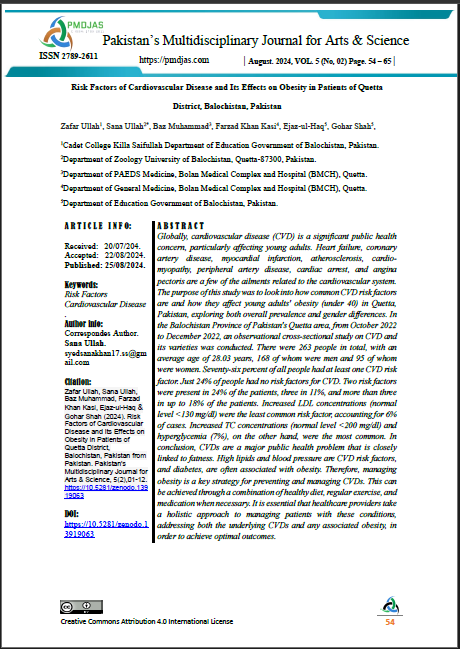RISK FACTORS OF CARDIOVASCULAR DISEASE AND ITS EFFECTS ON OBESITY IN PATIENTS OF QUETTA DISTRICT, BALOCHISTAN, PAKISTAN
DOI:
https://doi.org/10.5281/zenodo.13919063Keywords:
Risk Factors, Cardiovascular, DiseaseAbstract
Globally, cardiovascular disease (CVD) is a significant public health concern, particularly affecting young adults. Heart failure, coronary artery disease, myocardial infarction, atherosclerosis, cardio-myopathy, peripheral artery disease, cardiac arrest, and angina pectoris are a few of the ailments related to the cardiovascular system. The purpose of this study was to look into how common CVD risk factors are and how they affect young adults' obesity (under 40) in Quetta, Pakistan, exploring both overall prevalence and gender differences. In the Balochistan Province of Pakistan's Quetta area, from October 2022 to December 2022, an observational cross-sectional study on CVD and its varieties was conducted. There were 263 people in total, with an average age of 28.03 years, 168 of whom were men and 95 of whom were women. Seventy-six percent of all people had at least one CVD risk factor. Just 24% of people had no risk factors for CVD. Two risk factors were present in 24% of the patients, three in 11%, and more than three in up to 18% of the patients. Increased LDL concentrations (normal level <130 mg/dl) were the least common risk factor, accounting for 6% of cases. Increased TC concentrations (normal level <200 mg/dl) and hyperglycemia (7%), on the other hand, were the most common. In conclusion, CVDs are a major public health problem that is closely linked to fatness. High lipids and blood pressure are CVD risk factors, and diabetes, are often associated with obesity. Therefore, managing obesity is a key strategy for preventing and managing CVDs. This can be achieved through a combination of healthy diet, regular exercise, and medication when necessary. It is essential that healthcare providers take a holistic approach to managing patients with these conditions, addressing both the underlying CVDs and any associated obesity, in order to achieve optimal outcomes
Downloads






